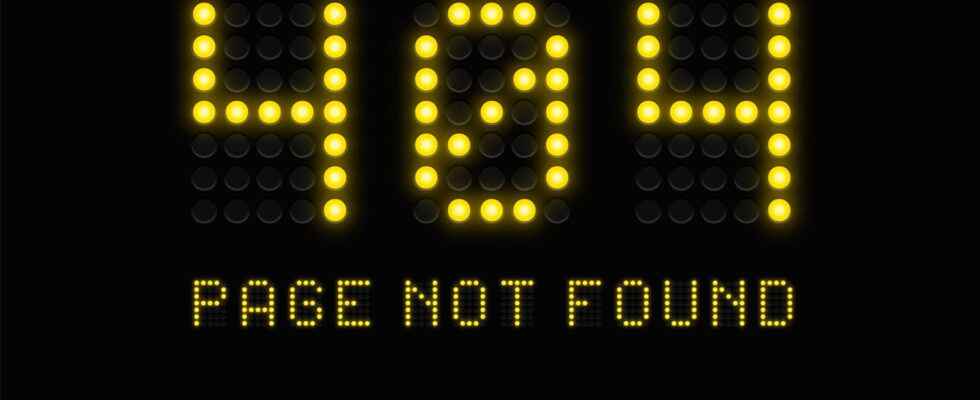The web can be temperamental at times. And during your browsing sessions, you have already come across cryptic messages indicating errors. Learn how to decipher them to understand the origin of the problem.
While you are surfing the Internet with your browser, you come across a site or a search on a cryptic message: Error 404. Enough to be puzzled and wonder what could have happened when everything was working perfectly until there. The culprit is not your Internet service provider since other sites you visit are displayed without problem. You are simply faced with an error as there are dozens of with the HTTP protocol (HyperText Transfer Protocol or hypertext transfer protocol in French).
It is actually an HTTP code that pops up when a request between a client (your web browser) and a server (the site you are trying to visit) encounters a problem. Based on the code displayed, you can determine where the glitch is coming from. During your navigation, you can thus come up against several types of error. They are categorized from 1 to 5. The most common are in categories 4 and 5 which refer to client side and server side errors, respectively. Here is the meaning of the most common codes and how to solve them… when possible!
What do the errors 400, 403, 404 and 408 mean?
Category 4 error codes indicate a problem with the client, that is, your web browser or the operations you are attempting to perform with it.
Error 400
Often accompanied by the Bad Request message (incorrect request in French), the 400 error often indicates a problem in the address entered (the URL). An extra or misplaced special character ({,%, =, etc.), for example. Easy to detect with short addresses, the error becomes difficult to identify with very long addresses with many special characters. If this message appears after clicking on a link, the link is incorrect.
403 error
Followed by the term Forbiden (Interdit in French), this code means that you are not authorized to access the page you are requesting. Even if your identification – in the case of access to an account on a web service – is validated, you probably do not have the necessary rights to view the content of this page.
404 error
This is probably the most common error encountered on the web. It can be accompanied by the message Not Found (not found in French), or Page Not Found (page not found), or sometimes by a humorous message from the owner of the site visited. The 404 error means that the page you are trying to view does not exist or no longer exists. It may have been deleted from the server by its owner, for example, which is why you could access it before but not now. She may also have changed her name and URL (web address). Finally, an error in the address entered (a typing error, for example) is also possible. Check the latter.
Error 408
Accompanied by the mention Request Time Out, this error indicates that the desired page takes longer to display than normally. This can be caused by a slow Internet connection that prevents the server from receiving the necessary information in the allotted time. The connection between the web browser and the server is then terminated. You may also have waited too long to enter requested information (such as a username, password or authentication code, for example).
What do 500, 502, and 509 errors mean?
Category 5 HTTP error codes refer to problems with the server of the website you are trying to access.
Error 500
Followed or preceded by the mention Internal Server Error, this error most of the time reflects a problem related to the operation of the server. It may, for example, be displayed when the latter is undergoing maintenance and it cannot logically respond to requests from website visitors. It could also be a problem with a file or directory on the website. In these cases, there is nothing else to do but wait for the site to be accessible again.
Error 502
Accompanied by Bad Gateway, the 502 error is one of the most common Category 5 errors. It indicates that the relay server (gateway or proxy) cannot forward your request to the back-end server that hosts the website you want to visit. The cause may be an overload of the server which is unable to respond to all requests. To find out, you can try to verify that the site you are looking to join is online and still accessible thanks to the service. Down for Everyone or Just Me (broken down for everyone or just me in French). Enter the name of the desired website and click on the button or just me. If the result is is upis that the site is functioning normally. Then restart your Internet browser or use a different one and try to connect again. If that doesn’t work, change the DNS (Domain Name System) servers. The one used by your Internet service provider may be temporarily faulty. To find out how to change DNS on your PC or Mac, see our DNS factsheet: how to change your domain name server.

Error 509
Sometimes marked with Bandwidth Limit Exceeded, this error indicates too many simultaneous connections to the website you want to join. Each website has a maximum concurrent visitor quota. When this is reached – in the event of high traffic, therefore -, the site can refuse the connection to new visitors. It can also be the victim of a distributed denial of service (DDoS) attack. Hackers multiply connections to the website’s server in order to overload and make it inaccessible. Again, you will have to wait before trying to connect again.
